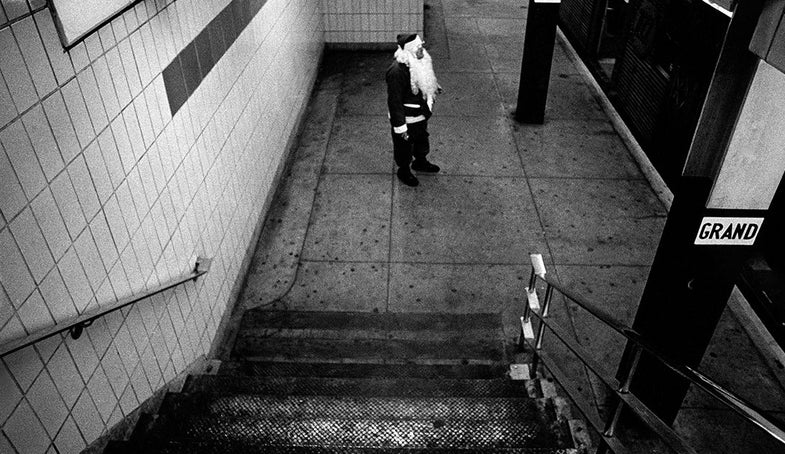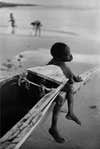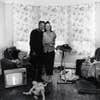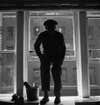“This photograph was taken in Kabul in the fall of 2003, during a parade in honor of the late Afghan commander Ahmad Shah Massoud. Massoud, the leader of the Northern Alliance and a fervent anti-Taliban commander, was killed by Tunisian Al Qaeda operatives posing as journalists, two days before the 9/11 attacks. The Afghanistan I know is a land of clashing contrasts, of raw beauty; its landscape scarred by centuries of wars fought against foreign armies and with itself. From 2001 to 2010, I have returned over and over again, with the hope of documenting the promise of peace and prosperity made by the latest invading powers. I soon realized the fragility of this promise. I found Afghanistan staring at a precipice, its free fall toward anarchy gaining strength throughout the country and no longer confined to the Pashto-speaking provinces where the Taliban was born and remains entrenched.” © Moises Saman—Magnum “When I began photographing the women who performed striptease at carnivals in the early 1970s, I had two Leicas: One for color, the other black and white. I did portraits with a medium format camera. As I immersed myself further into the world of the Girl Show, I realized that the ASA of color film at that time couldn’t handle the exposure I needed. Daylight was fine, but by night I ended up shooting handheld at low shutter speeds and still had to push the B&W; film to 1600 to render the interiors of the dressing room and performances. This door was the entrance to the tent for ‘Men and men only, no ladies, no babies.’ Being excluded provoked me to sneak in disguised as a young man. I’m now just beginning to rediscover the color buried in my archive, which makes me think about how different the work then would be with digital today.” © Susan Meiselas—Magnum “This isn’t a long lost photo, but one that I made recently in Rochester, N.Y. It is an unknown image though, because I’m still busy editing and revisiting the body of work I made in Rochester. One day I met the family in this photograph. They were a bit curious about what exactly I was doing there, but after a while, they got more comfortable, enough so that the kids forgot I was there, and that comfort allowed this moment to happen.” © Paolo Pellegrin—Magnum “I was wandering along a beach in West Africa at dusk when I spotted this lad on the boat, either dreaming or deep in thought. I managed to squeeze off a vertical frame without his being aware of me, just as a woman carrying a bowl walked past. I also shot a horizontal frame of the scene. I had been working in Africa and in those days, if we weren’t returning to Europe immediately, we shipped the film back to Magnum in Paris. Of the two frames I made, the horizontal pic was edited, published and seen by many, but to this day, I still prefer the feeling in this vertical.” © Ian Berry—Magnum “While working on “God, Inc.”, my project in the US about religion and nationalism (1990-1991), I occasionally photographed non-religious subjects just to stay in shape. During Bike Week in Daytona Beach, I was following a group of biker preachers when I stumbled upon this girl in a tattoo shop. She was standing half naked in the window, probably looking in the mirror after the tattoo was done. I was not the only one who had spotted her.” © Carl De Keyzer—Magnum “The picture was shot in Jaipur in 2000 during the annual kite festival. Thousands of people on the city rooftops parry with fighting kites: the aim to cut the string of feuding kites. The strings are dipped in a mixture of glass shards and glue. Truly, this is a photograph that I had forgotten I had taken until quite recently. I recalled the event and the assignment, but not this particular touching moment. I really don’t know how many photographs I have taken. It makes me wonder how many ‘touching moments’ I’ve captured that I’ve somehow forgotten about.” © Stuart Franklin—Magnum “I took this picture of Marion in Croatia around 2003. We were having breakfast the morning after a quarrel, and her eyes are puffy from crying. At the time, it was a journal entry or a way to remember a moment. It did not cross my mind that pictures of my personal life would become so much a part of my work. Years later I would photograph my family in color and that would become my book, SON. While making that book, I looked back through my archives with new eyes, and pictures like this seemed charged with new and richer meaning than I was able to recognize at the time.” © Christopher Anderson—Magnum “When I was 22 or 23, I took a semester long photography course. We had an assignment, and I decided I want to follow Santa Claus. At the time, there were all these guys around New York dressing up as Santa for Volunteers of America, and they’d collect donations outside Macy’s and similar locations. After they’d collect, they’d head back to the volunteers headquarters on Houston Street and go out drinking—most of the Santas were alcoholics. I took this picture because in my head, I remember thinking, ‘Why is Santa taking the A train. Where is his sleigh?’ Later, I took this photograph to an editor at the New York Times, and he loved it, but said it’s ‘Too late to publish for Christmas.’ Well, I missed the boat that Christmas, so I guess I’ll catch the boat 46 years later.” © Bruce Gilden—Magnum “This was photo was taken on the set of L’important c’est d’aimer by Andrei Zulawski in 1974 It was my first film set. I had only one year of professional photography behind me, and I was just finishing university. With Kinski, there was also Romy Shneider, Jacques Dutronc, Fabio Testi, and more. All these prestigious figures made me feel quite intimidated as a beginner, but I was so fascinated, watching in silence what was unfolding in front of me. I discovered amazing intricacies that existed between the mood of the film and the inner psychology of the actors during the shooting. I ended up unable to completely differentiate between what was emotionally happening in the fictional film, and what was happening with the real life actors. Andrei Zulawski has always excelled in handling this kind of situation. The film crew and producers had given me almost full ‘carte blanche,’ so I was left alone with the actors. Kinski fascinated me most—his sudden moods swings, from very calm to incredibly violent. He was struggling with his demons and playing with the struggle. With me, he was attentive and kind. It was while the crew was setting up the lights that Kinski began to improvise this moment, began to play. It weighed on me, the mood he inhabited a few moments after this frame was made. After the take ended, he got up and walked away slowly towards the bedroom window. He cried. We both stayed silent.” © Jean Gaumy—Magnum “One of the absurd things about photography is the amount of pictures one takes that end up in a box, never to be seen again. Nearly all of the images I’ve ever taken have ended up unseen in a box. I took this image in Abkhazia in 2005, while I was working on my book “Satellites.” It shows girls doing their hair in front of a bombed out apartment block. It was a sweet little human moment. But later that same evening I took another image of an old woman walking in front of the same building that was slightly more dramatic. And just like that, the image of the four girls had to go.” © Jonas Bendiksen—Magnum “In the winter of 1965, I explored the industrial wasteland across the Hudson River from New York City to New Jersey. I traveled on dirt roads that led through the brackish marshlands with mountainous garbage dumps used for landfill. There I met Willie Royka, who with his young son Willie Jr., picked the dumps for scrap metal in the warmer months and trapped muskrats on the colder days when the pelts were thicker. They led me deep into the New Jersey meadows where tall cattails obscured the Manhattan skyline and the marshlands became a pristine wilderness. At low tide, we made our way through the muck to the traps and the drowned muskrats. At the end of the day they invited me home, where they skinned and dried the pelts for sale. They also removed the musk gland that can hold the aroma used in perfume-making processes. It was after I photographed this family that I thought it would be interesting do a film about their lifestyle titled, Living Off the Land. Though this image has been published before in two of my books, it still continues to go unnoticed.” © Bruce Davidson—Magnum “In 1946, I was 18 years old and certain that I would become a professional photographer. While still in public school, I managed to save enough to buy my first serious camera—a Rolleiflex with which I shot all my pictures for several years at belly level. Eventually, I moved up to eye level, shooting where I still am with modern cameras. Recently, while looking in to my old proof sheets and seeing pictures I had taken over 60 years ago, I was pleasantly surprised at what I shot while still a teenager. The picture of a window washer taken 68 years ago is one of those ‘found’ images and a small part of a rescue from the depths of my archive.” © Elliott Erwitt—Magnum Most photographers can attest that the majority of their life’s work has never been seen by anyone. Jobs call for a tight edit, a single shot to tell an entire story, and once you have it, you move on, forgetting the shots that almost made it. Negatives are tucked away in binders and shoved in old shoe boxes in the tops of closets and under beds, while digital files sit on old hard drives collecting dust in desk drawers.
It’s a familiar story for anyone who shoots regularly. A few months ago the Magnum photographers challenged one another to dig through those archives and select a single photograph that they love, but for whatever reason didn’t make that initial cut. These forgotten frames from the likes of Moises Saman, Elliott Erwitt, Bruce Davidson, and more can be purchased through the Magnum website during the “Archive Dive Square Sale.” Thirty seven Magnum photographers are participating in the”Archive Dive,” selling rarely seen signed 6×6 prints for $100 each.
“When you’re editing you’re editing towards a certain end, and when that end is met you forget about the pictures that didn’t make it,” Larry Towell, who is participating in the sale, told the Lens Blog . “What this Magnum project has done is allowed us to go back and re-edit. There isn’t enough re-editing being done today.”
Prints will be available to purchase through Nov. 14, 2014. A box set of all 37 photographs is available for $2,850.













